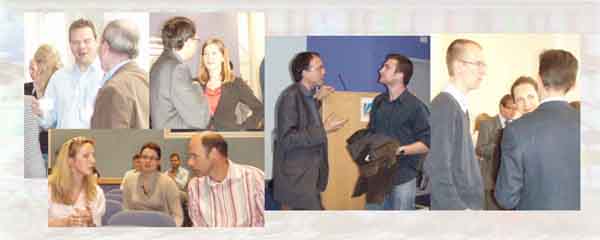

Investigators and Projects

The 2009 Vision Research meeting took us to the 'Frontiers of Ocular Regeneration' . This is an exciting strand of translational research in which great strides are being made that bring the latest discoveries in the basic science of cell development to the clinic. The twentieth century saw the birth of successful solid organ transplantation. Aspirations for 21st century focus on replacing individual cell populations in the retina, to restore visual function. In the first session 'The Challenge of Generating Stem Cells' Julie Daniels and Jane Sowden from London took us from stem cells in the limbus of the cornea to protocols for restoring rod and cone function in the retina, while Jess Cooke reported studies on reprogramming mouse embryonic stem cells. The work touched on both the legal regulatory hurdles facing the practical application of these studies, as well as the beautiful and subtle control of the stages of cell differentiation. It is possible to see over the horizon a new age in which cell populations are programmed for transplant into specialised target organs; but problems relating to the introduction of viral genes, immune rejection and the cost of personalised therapy remain important challenges.
In the second session, 'Artificial Biointerfaces', the meeting considered some of the successes and constraints of engineering synthetic tissues. Monica Berry covered the complexity of inputs that cells integrate, as they interact with and produce cell matrix. Lucia Kuffova shared exciting data on the use of tissue engineered corneas, generated from recombinant human proteins and trialled in a group of patients in Sweden. Ed Regan spoke about electronic cell interfaces and looked forward to a time when electrical recordings from cells, grown on biochips, will usher in a new age of single cell and whole tissue electrophysiology.
The session on 'Emerging Stem Cell Therapies' stretched beyond remodelling in the eye to cover tissue engineering of cartilage. One emerging theme of this session was the importance of timing, as a dimension in the regulation of differentiation, to achieve normal function and in selecting the right moment to move to the patient. Anthony Hollander summarised the techniques necessary to prepare cartilage from bone marrow derived mesenchymal stem cells and recounted the inspiring case of bronchus replacement, made possible by the reintroduction of autologous cells into decellularised tissue. Rachael Pearson talked about checkpoints in migration into the retina and how tackling these could dramatically increase the efficiency with which photoreceptor precursor cells repopulate the retina. This reconstitution of the retina is now reaching a point where it can be detected as as useful vision in animals previously unable to see at low light levels, which offers great hope for future translation.
The day finished with a set of talks that highlighted 'Translation in Practice'. John Armitage extolled the virtues of the Bristol Eye Bank, run as a national resource and made much more effective as a research resource by its collection of detailed follow-up data on the outcome of corneal grafts. It is striking that by ten years post transplant, kidneys actually survive better than corneas. Derek Tole expounded on the treatment of limbal stem cell deficiency before Lyndon da Cruz returned us almost to where we had begun, considering the implantation of single cell populations, but this time focussing on retinal pigment epithelium. His work is poised to enter clinical trials next year and his talk captured the fast pace and excitement of this advancing field.

We are very grateful to Novartis, Pfizer and Alcon for their generous sponsorship of this meeting, as well as to the National Eye Research Centre, which has supported the Vision Research meeting from its inception